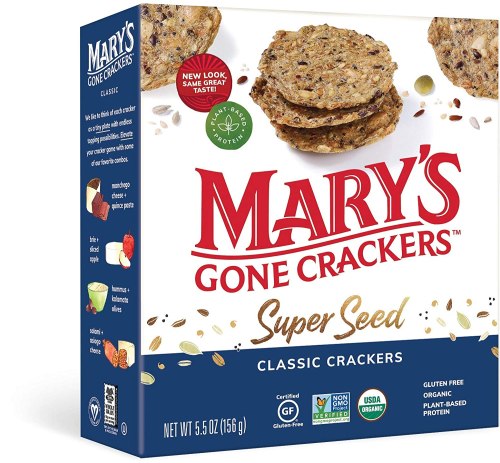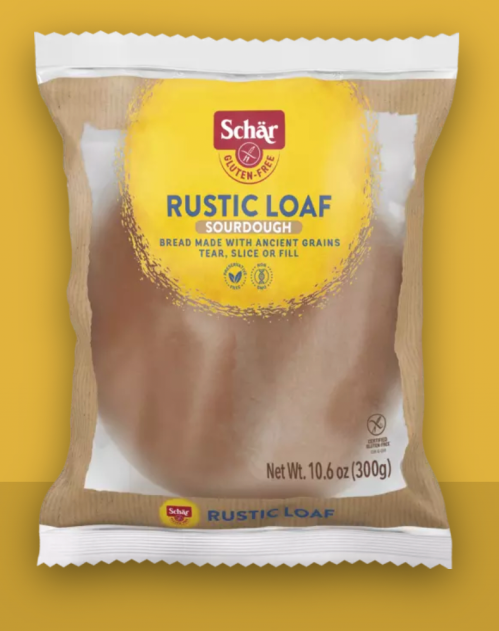Our editors independently select these products. Making a purchase through our links may earn Well+Good a commission
The Best Gluten-Free Foods on Store Shelves Right Now, According to an RD
If you’re celiac or intolerant of certain cereal grains, these are the best gluten-free foods to buy, says a registered dietician.

Eating gluten-free may be a lifestyle choice for many, but for at least 3 million Americans with celiac disease, finding the best gluten-free foods to eat is a necessity. That’s because when a person with celiac disease (which is an autoimmune disorder) consumes any amount of gluten—the protein found in wheat, barley, and rye—the immune system will attack and damage the small intestine. This alters and inhibits the absorption of many essential nutrients in the body. If left undiagnosed or poorly managed, celiac disease can lead to the development of other autoimmune disorders, health conditions, and complications.
Experts in This Article
clinical dietitian and founder of Chelsea Nutrition
registered dietitian and author of The Better Period Food Solution.
In addition, it’s estimated that about 18 million individuals in the U.S. may have non-celiac gluten intolerance, which is a term used to describe individuals who do not test positive for celiac disease, but have similar symptoms to those who do and also find symptom relief by omitting gluten from their diets.
Right now, there is no validated clinical evaluation for proving gluten intolerance; it is primarily diagnosed by process of elimination and anecdotal reports. But before you cut gluten out of your diet and start shopping for gluten-free foods, there are some things you should know about the protein first. Ahead, I, a registered dietitian and culinary nutritionist, walk you through it with added input from NYC-based dietitian Jennifer Maeng, MS, RD, CDN, LD, CNSC.
Generally, What Foods Are Gluten-Free?
Considering gluten is found in a protein found in wheat, barley, rye, and triticale, Maeng says that gluten-free foods are those that don’t include those ingredients. Once upon a time, that meant you could safely assume that bread, pasta, and other heavy carb foods were off the table for those with celiac disease, as well as those embracing a gluten-free diet. However, nowadays, so many gluten-free alternatives exist that many people feel the need to double-check labels, given gluten-free versions of bread, pasta, pizza crust, and other once-off-limits foods are constantly debuting.
Still, if you don’t want to take any chances—or if you don’t want to be bothered with having to read labels—Maeng says that an easy solution is to fall back on the most tried and true gluten-free foods, including fruits, vegetables, fish, meat, eggs, dairy, beans, nuts, seeds and oils.
Why Is Gluten Important in Food?
Gluten plays a key function in food by helping to maintain its shape and providing structure. The best way to understand what gluten does is by thinking of the chew found in a bagel or pizza crust, or the elasticity you can see when you twirl pasta noodles. Without gluten, many breads, pastas, and baked goods would lack this integral aspect of texture and mouthfeel, which adds so much to the eating experience.
But thanks to increased demand for gluten-free products, innovative producers, and increased access to gluten-free grains, there are a number of high-quality products on the market that are delicious whether you have to go gluten-free or not.
Below, you’ll find a list of some of the best gluten-free foods that taste great, without any sacrifice, which I’ve put together with some input from my colleagues and clients.
Learn more about gluten by watching the video below:
The best gluten-free foods, according to a registered dietitian

Best gluten-free breakfast cereal: Forager Project — $5.00
Forager Project originally launched as a non-dairy yogurt brand, but it recently came out with an organic, gluten-free cereal that we can’t get enough of. This O-shaped cereal is made from cassava root and navy beans providing gut-healthy fiber that is completely grain free. It comes in four flavors: lightly sweetened, cinnamon, strawberry, and chocolate. In addition to its great flavor, it is exceptionally crunchy, certified organic, vegan/dairy free, soy free, gluten free, and Kosher. But the best part is that unlike most other sweetened cereals, Forager Project’s has minimal added sugar. In fact, each cup contains only two to four grams total, plus a single serving has four grams of fiber and four grams of protein (primarily from peas).

Best gluten-free crackers: Mary’s Gone Crackers — $9.00
Mary’s Gone Crackers is not new to retail shelves, but the company recently came out with some innovative, new flavors. All are great, but the Seaweed & Black Sesame variety is a favorite! The company makes three main types of crackers: original, super seed, and real thin, and all are certified gluten-free, nut-free, non-GMO verified, vegan, and organic.

Best gluten-free tortilla: Siete Foods — $9.00
Siete Foods was founded by a Mexican-American family in Texas inspired by health reasons to make grain-free versions of the traditional flour and corn tortillas they frequently enjoyed. All products are gluten, dairy, and soy-free, vegan, and non-GMO, so they don’t contain the preservatives found in many other similar products. For a nutty and buttery flavor, opt for the almond-flour tortillas, while the cassava-flour tortillas will be the best pick for a traditional tortilla swap. Pro tip: Check out their cassava-based, burrito-size tortillas, specifically made bigger for all those yummy fillings.

Best gluten-free bread: Schär — $6.00
For more than 35 years, Schär has been one of the leaders in terms of research and development of high-quality, gluten-free food products and baked goods—the company is named after a doctor, Dr. Anton Schär, who began experimenting and producing gluten free products for his patients (primarily children) with digestive issues in the early 1920s. In fact it houses a research center in Trieste, Italy dedicated to testing new ingredients and combinations that maintain high nutritional integrity and taste. (It also has an established international scientific committee to further build on its expertise.)
To this day, their products stand out as some of the best, but the breads are consistently mentioned time over time as a favorite among bread-lovers who follow gluten-free diets. Choose from sliced bread, bagels, and rolls with lots of options within each category—the ciabatta rolls are a must-try! And the Rustic Loaf is also a great sourdough option made with ancient grains. What’s more, Schär’s sliced breads are higher in fiber than most other gluten-free breads, and come in a variety of options including deli-style, multigrain, and white.

Best gluten-free snack: Yolélé — $4.00
Yolélé is a company credited with introducing the US market to the West African super grain fonio, a very tiny, gluten-free member of the millet family with a low glycemic index. As part of its product line, the company makes truly irresistible chips made from a base of fonio and cassava, and flavored with bold, vibrant, West African flavors including the anti-inflammatory super green moringa and tangy baobab. All chips are vegan, Kosher, certified gluten free, non-GMO, void of potatoes and peanuts, and contain zero trans fat (and very low saturated fat). In addition to being great for snacking straight out of the bag, they’re also delicious added to a wrap or sandwich for some crunch, paired with your favorite dip, or used as a base for a twist on traditional nachos.
Common Misconceptions About Gluten-Free Products
Something that’s important to remember is that gluten isn’t only in food—it’s in supplements, too. “Unfortunately wheat and gluten wheat are commonly used in many different ways such as binding agent (in supplements), thickeners, and even flavorings, so it is important to read the labels thoroughly to ensure a product is gluten-free,” Maeng says. “Cross contamination is also very common when gluten-free products are manufactured in a facility that produces gluten products.”
Additionally, another common misconception about gluten-free food products—even the best gluten-free foods—is that they’re innately healthy. “If you are able to tolerate gluten, there is no reason to seek out gluten-free food products,” Maeng says. “Many gluten-free products are highly processed with many different filler ingredients to become what they are not.”
Sign up for the Well+Good SHOP Newsletter
Get exclusive deals on wellness, beauty, fitness, and food products that have been hand-picked by our editors.
Got it, you've been added to our email list.







